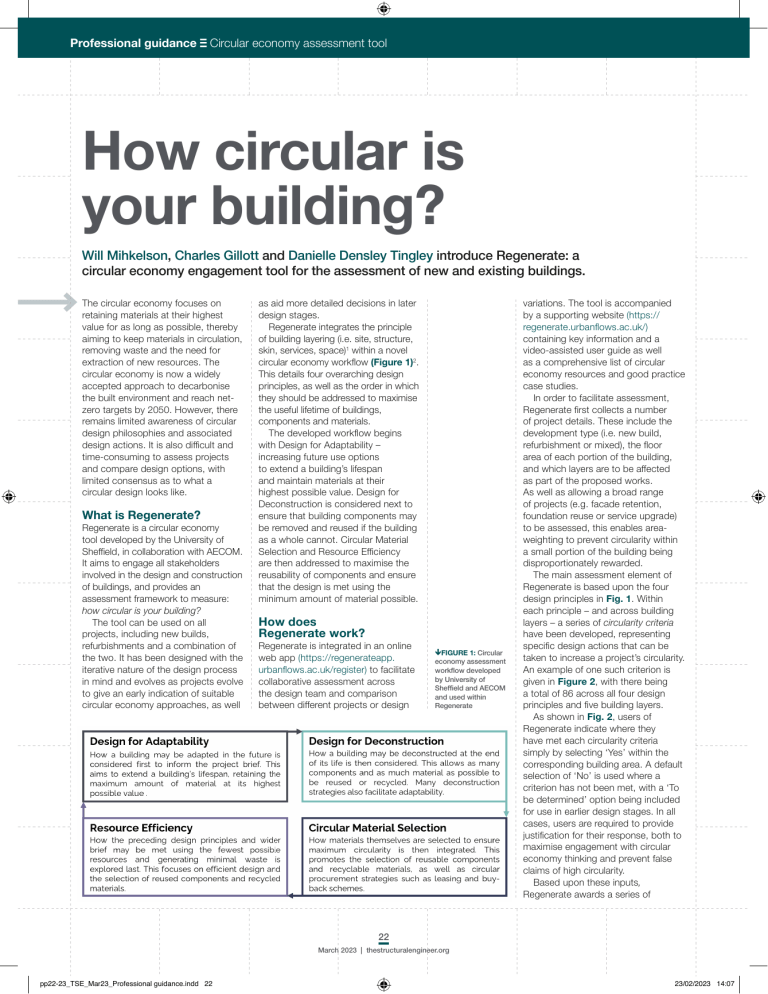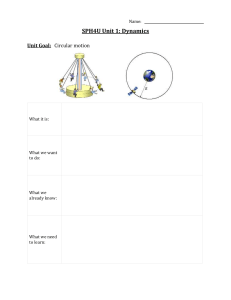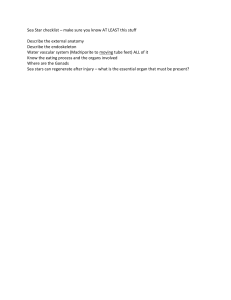
Professional guidance Circular economy assessment tool How circular is your building? Will Mihkelson, Charles Gillott and Danielle Densley Tingley introduce Regenerate: a circular economy engagement tool for the assessment of new and existing buildings. The circular economy focuses on retaining materials at their highest value for as long as possible, thereby aiming to keep materials in circulation, removing waste and the need for extraction of new resources. The circular economy is now a widely accepted approach to decarbonise the built environment and reach netzero targets by 2050. However, there remains limited awareness of circular design philosophies and associated design actions. It is also difficult and time-consuming to assess projects and compare design options, with limited consensus as to what a circular design looks like. What is Regenerate? Regenerate is a circular economy tool developed by the University of Sheffield, in collaboration with AECOM. It aims to engage all stakeholders involved in the design and construction of buildings, and provides an assessment framework to measure: how circular is your building? The tool can be used on all projects, including new builds, refurbishments and a combination of the two. It has been designed with the iterative nature of the design process in mind and evolves as projects evolve to give an early indication of suitable circular economy approaches, as well as aid more detailed decisions in later design stages. Regenerate integrates the principle of building layering (i.e. site, structure, skin, services, space)1 within a novel circular economy workflow (Figure 1)2. This details four overarching design principles, as well as the order in which they should be addressed to maximise the useful lifetime of buildings, components and materials. The developed workflow begins with Design for Adaptability – increasing future use options to extend a building’s lifespan and maintain materials at their highest possible value. Design for Deconstruction is considered next to ensure that building components may be removed and reused if the building as a whole cannot. Circular Material Selection and Resource Efficiency are then addressed to maximise the reusability of components and ensure that the design is met using the minimum amount of material possible. How does Regenerate work? Regenerate is integrated in an online web app (https://regenerateapp. urbanflows.ac.uk/register) to facilitate collaborative assessment across the design team and comparison between different projects or design FIGURE 1: Circular economy assessment workflow developed by University of Sheffield and AECOM and used within Regenerate variations. The tool is accompanied by a supporting website (https:// regenerate.urbanflows.ac.uk/) containing key information and a video-assisted user guide as well as a comprehensive list of circular economy resources and good practice case studies. In order to facilitate assessment, Regenerate first collects a number of project details. These include the development type (i.e. new build, refurbishment or mixed), the floor area of each portion of the building, and which layers are to be affected as part of the proposed works. As well as allowing a broad range of projects (e.g. facade retention, foundation reuse or service upgrade) to be assessed, this enables areaweighting to prevent circularity within a small portion of the building being disproportionately rewarded. The main assessment element of Regenerate is based upon the four design principles in Fig. 1. Within each principle – and across building layers – a series of circularity criteria have been developed, representing specific design actions that can be taken to increase a project’s circularity. An example of one such criterion is given in Figure 2, with there being a total of 86 across all four design principles and five building layers. As shown in Fig. 2, users of Regenerate indicate where they have met each circularity criteria simply by selecting ‘Yes’ within the corresponding building area. A default selection of ‘No’ is used where a criterion has not been met, with a ‘To be determined’ option being included for use in earlier design stages. In all cases, users are required to provide justification for their response, both to maximise engagement with circular economy thinking and prevent false claims of high circularity. Based upon these inputs, Regenerate awards a series of 22 March 2023 | thestructuralengineer.org pp22-23_TSE_Mar23_Professional guidance.indd 22 23/02/2023 14:07 Circular economy assessment tool Professional guidance FIGURE 2: Example circularity criterion (Design for Deconstruction 2) detailing compliance in ground-floor retail space (representing one-third of total project floor area) alongside associated credit award and textbased justification circularity credits. These take a maximum value of 1 for each criterion, which is apportioned based upon the floor space associated with each building area (as shown in Fig. 2). Beyond this main assessment element, Regenerate may also be used to create circular economy statements, such as those required by the Greater London Authority (GLA), as a result of its inclusion of populatable Bill of Materials and Recycling and Waste forms. What can Regenerate tell me? To assess how circular a building is, the credits awarded for different circularity criteria are summed for use in various outputs. Both tabular and graphical summaries are provided (Figure 3), with attained credits being split up by circularity principle and building layer. In addition to the circularity of the assessed building as a whole, these outputs help to highlight the relative success of different strategies and stakeholder groups, as well as key areas for improvement. In addition to engaging key stakeholders with the circular economy and influencing decisions throughout the design process, outputs from Regenerate may be used directly in the preparation of circular economy statements. This is facilitated by the automatic generation of PDF outputs of Awarded Credit summaries (such as in Fig. 3), as well as key GLA requirements such as Bill of Materials and Recycling and Waste metrics. How do I get Regenerate? Regenerate is free to use and available along with supporting information at https://regenerate.urbanflows.ac.uk. If you have any queries or would like to give feedback, please contact regenerate@sheffield.ac.uk. REFERENCES 1) Brand S. (1994) How buildings learn: what happens after they’re built, New York, NY: Viking FIGURE 3: Example summary output from Regenerate, showing attained credits disaggregated by principle and building layer in both graphical and tabular form 2) Gillott C., Mihkelson W., Lanau M., Cheshire D. and Densley Tingley D. (2023) ‘Developing regenerate: a circular economy engagement tool for the assessment of new and existing buildings’, J. Ind. Ecol.; https://doi.org/10.1111/jiec.13377 23 thestructuralengineer.org | March 2023 pp22-23_TSE_Mar23_Professional guidance.indd 23 23/02/2023 14:07

